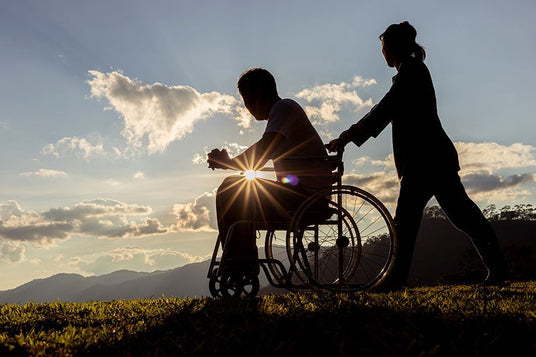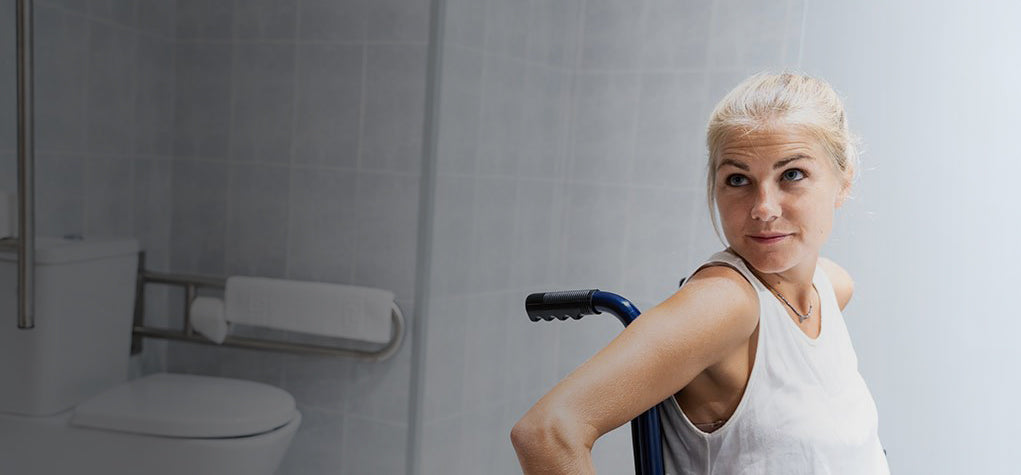
-
Welcome to our in-depth resource for: physical rehabilitation and bathroom use
Rehabilitation is a different story for every person who goes through it. In many cases, the process can be long and challenging as the individual goes through physical therapy to regain body movement. Physical rehabilitation might be the result of an accident, a health condition or a sports injury. Our community of Showerbuddy users who are coping with physical rehabilitation engage with us because of the need for help during bathroom use. An environment that’s hazardous to begin with, the bathroom needs to have measures in place to protect the mobility impaired individual and their support person.
In this resource, we provide some insights around bathroom use during physical rehabilitation, from the perspective of an assistive equipment provider. For more information related specifically to your physical rehabilitation, consult with your physical therapist, occupational therapist or health provider directly.
-
![Image of a Showerbuddy bathroom transfer system installed in a modern bathroom, showcasing the mobility chair and transfer track against a backdrop of white tiles and dark flooring.]()
MODEL SB1 “ShowerBuddy”: One of the most defining features of the Showerbuddy Transfer Range is its transfer bridge design – allowing clearance over the edge or lip of a shower base.
Our: Helpful Guides
-
![Image of a woman in a wheelchair in a bathroom, reaching for a grab bar, highlighting accessibility and mobility assistance in bathroom settings.]()
Using The Toilet With An Injury
It’s not until we’re dealing with a serious injury that we realise just how difficult the body movements are during toilet use. In this guide we provide some insights around these challenges and how those recovering from an injury can navigate this process easier.
-
How To Bathe Comfortably During Rehab
Bathing should be one of the more relaxing moments of the day. But without the right support in place, it can be anything but when rehabilitating a physical impairment. In this guide we draw upon our extensive knowledge in the area of bathing with mobility challenges to provide some useful tips.
Equipment To Help Bathroom Use When Injured
A key part of any physical care plan in the bathroom is the assistive technology that’s employed. Having a good process and equipment in place can remove a lot of stress involved with bathroom use. We cover some of the key pieces of equipment that may be worth investigating.
Common Injuries And How They Prevent Bathroom Activities
With bathroom use requiring all sorts of movements and parts of the body to carry out, there are many different types of mobility impairments that result from injuries – each of these need to be catered to differently. In this guide we cover some of the more common injuries we see within our Showerbuddy community and the tasks they can prevent or hamper.
Planning Bathroom Routines During Rehabilitation
Having a good plan in place to use the bathroom is as important as the support and equipment itself. Being a very personal space, the bathroom process should be collaborative and make the individual as comfortable as possible. Our guide provides some useful insights around being prepared during the rehabilitation process.
-
![Image of a Showerbuddy transfer system over a bathtub next to a toilet, designed for safe and easy movement into the bath, in a modern bathroom with grey walls and white fixtures.]()
Make bathroom use easier
MODEL “TubBuddy Tilt” SB2T: One of our most popular models with a bridge transfer system to clear the edge of a bathtub and a tilt feature for user comfort.
-
5 Ways To Make Bathroom Use Easier During Rehabilitation
Bathroom use isn’t easy with a physical injury or condition that prevents full mobility. With serious injuries that leave parts of the body entirely incapacitated for a period of time, bathing and toileting can be even more of a challenge. But there are things that families and support people can do:
1. Bathroom atmosphere.
Create a bathroom atmosphere that’s inviting, open and hazard free. With the manoeuvring and physical support needed for someone going through a physical recovery, the bathroom shouldn’t create more barriers to the showering and toileting process.
2. Detailed planning
Have a detailed plan in place straight away. Lack of planning or understanding as to your loved one’s physical limitations will make it hard to offer the correct help. The OT should have a plan designed around the individual’s needs and home that they will onboard you to as the support person.
3. Communication
Listening and cooperation. A mistake that can really derail the bathroom experience for someone going through physical rehabilitation is when they don’t feel heard. Ultimately, the bathroom (and any daily tasks for that matter) should be up to the individual. If the bathroom routine doesn’t feel right or in line with personal preferences, there’s more opportunity for stress, frustration and arguments. Much of this can be avoided when open discussion is allowed and the OT’s care plan has been contributed to by the individual themselves.
4. Simplicity
Keeping it simple. Over complicating the process of bathroom use can just add to the stress and exertion of all involved parties. A toilet process, bathing process and washing up process may be all that’s required. Any non-essential activities that may have otherwise been completed in the bathroom may be worth bringing out into another room – getting hair done, applying makeup, getting dressed etc.
5. Use good equipment
Make use of good equipment. Physical rehabilitation will require a range of assistive technology that helps re-engage the body and bring back key movements. But at home in the bathroom equipment can be used to make bathing and toileting easier. There are a number of options available, some of which you’ll learn more about in this resource.

Recovery stories
Do you have a recovery story? We want to hear from you.
Hearing about other journeys through physical rehabilitation can really help someone experiencing it themselves.
We’d like to hear from anyone who has been through the trials and tribulations of an injury or condition that required rehab. How was your bathroom experience? What tips do you have for others going through this? Reach out to us via our contact page and we’ll chat to you about sharing some of your story in this resource.






